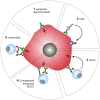Mechanisms of action of CD20 antibodies
- PMID: 23226614
- PMCID: PMC3512181
Mechanisms of action of CD20 antibodies
Abstract
Therapeutic monoclonal antibodies (mAbs) that target the CD20 antigen on B cells are successfully used in the clinic for the depletion of B cells to treat various forms of cancer and autoimmune diseases. The first CD20 mAb, approved by the FDA in 1998, was rituximab (RTX) and since then it has been widely used to treat more than one million patients thus far. The success of RTX has led to a general interest in the mechanism of action of CD20 mAbs. CD20 mAbs can induce tumor killing via various mechanisms, such as direct induction of apoptosis, antibody-dependent cell-mediated cytotoxicity (ADCC) or complement-dependent lysis (CDC). Although we now understand these mechanisms better, it is still unclear which of these mechanisms is the most important for in vivo RTX action. Not every patient respond to RTX treatment and eventually the overwhelming majority will experience a relapse. Therefore, there is an urgent need to improve the efficacy of CD20 mAbs. This review aims to summarize our current understanding on the mechanism of action of CD20 mAbs.
Keywords: Antibodies; CD20; Fc receptors; apoptosis; complement; complement receptors; effector mechanisms.
Figures

References
-
- O’Keefe TL, Williams GT, Davies SL, Neuberger MS. Mice carrying a CD20 gene disruption. Immunogenetics. 1998;48:125–132. - PubMed
-
- Uchida J, Lee Y, Hasegawa M, Liang Y, Bradney A, Oliver JA, Bowen K, Steeber DA, Haas KM, Poe JC, Tedder TF. Mouse CD20 expression and function. Int Immunol. 2004;16:119–129. - PubMed
-
- Cragg MS, Walshe CA, Ivanov AO, Glennie MJ. The biology of CD20 and its potential as a target for mAb therapy. Curr Dir Autoimmun. 2005;8:140–174. - PubMed
LinkOut - more resources
Full Text Sources
Other Literature Sources
